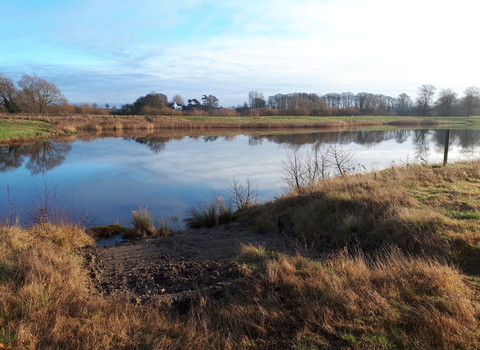
Ringlet ©Guy Edwardes/2020VISION
Bishop Monkton Railway Cutting Nature Reserve
Know before you go
Dogs
When to visit
Opening times
Open at all times.We recommend a 1 hour trip for this reserve, or make a day of it with a visit to nearby Burton Leonard Lime Quarries, Staveley and Ripon City Wetlands.
Best time to visit
May to September- the time for an insect bonanza!About the reserve
It’s easy to miss Bishop Monkton Railway Cutting from the road – look for the gateway to the reserve just before the humpback bridge – but once you’ve found it, you’ll quickly become immersed in a tranquil haven.
In an area dominated by large arable fields, this strip of grassland, flower-rich meadow and dense scrub is an oasis for wildlife. The cutting, originally carved out of the magnesian limestone landscape to make way for the now-disused London and Northeast Railway, is rich in insect life. Bees and butterflies can refuel along a corridor of wildflowers, while tussocky grasses provide homes and feeding grounds for small mammals, beetles and other insects, and thickets of brambles and scrub offer great nesting sites for birds.
This reserve is the perfect place to get away for some peace, quiet and solace in nature, even if you don’t have much time.
Habitat
Contact us
About
Cut into the magnesian limestone belt, this stretch of the now disused London and North Eastern Railway line provides ideal conditions for lime-loving plant species. Once the railway went out of use nature began to take the site over, with flourishing wildflowers and the gradual establishment of trees and scrub around the boundaries of the site. This site now comprises an area of increasingly rare, unimproved neutral and calcareous grassland, supporting a good range of plants, including cowslip, wild marjoram, ox-eye daisy, bird’s-foot trefoil, lady’s mantle, salad burnet and St John’s Wort, creating an attractive swathe of colour in May, June and early July.
The perimeter is bounded by a dense belt of scrub, providing an important habitat for birds, mammals and invertebrates. With over 70 species of moths recorded, try visiting in the evening to find some of them yourself!
The scrub is particularly significant in the local area, as the nature reserve is surrounded by arable farmland that provides few such habitats. Management of the nature reserve focusses on maintaining the extent and quality of the grassland, along with its margin of scrub.
Seasonal highlights
- Spring: Plants - Cowslip; Bird's-foot trefoil; Hawthorn blossom
- Summer: Plants - Common spotted orchid; Salad burnet; Invertebrates - Ringlet; Gatekeeper
- Autumn: Mammals - Roe deer; Birds - Fieldfare; Redwing; Bullfinch
- Winter: Birds - Kestrel; Barn owl; Mammals - Stoat
History
Part of the Harrogate to Ripon line of the London and North Eastern Railway, this section became disused in 1967. Whilst the line was active a railway worker’s hut with a garden was located by the side of the track and a number of garden plants have survived and are still in evidence on the site today. Whilst not native, these plants provide additional food sources for insects within the nature reserve and give tantalising glimpses into the industrial past of the site.
Directions
Public transport
A bus route passes through the village of Burton Leonard (although the nature reserve is some distance outside the village). A top tip from a regular visitor said "Take the number 36 Ripon - Harrogate - Leeds bus and get off at Bishop Monkton crossroads and walk down the hill. If you then walk down to Bishop Monkton you can then go through the village, along the riverside and then along the canal towpath back into Ripon.
By car
The nature reserve lies west of the village of Bishop Monkton. From Harrogate take the Bishop Monkton turning off the A61 Ripon road; continue over the hump back bridge towards the village. Turn round and return to park on the left hand verge, well away from the bridge, which is ‘blind’ and used by fast traffic. Entrance to the site through the farm gate close to the bridge and a kissing gate approximately 20m down the edge of the field.
Did you know?
Over 70 species of moth have been recorded here!

The autumn colours were even more beautiful when the sun came out
Photo Credit - Telling our Story Volunteer, Sara


